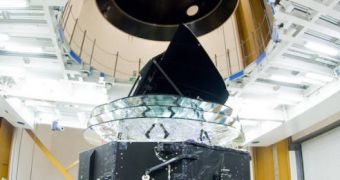Preparations for the scheduled May 14th launch of the European Space Agency's twin observatories, Herschel and Planck, are now developing at full speed, officials from the agency have recently announced. After the Planck telescope was installed over the core stage of its carrying Ariane 5 delivery system last week, it has only been recently encapsulated in a canister-shaped dispenser device, known as SYLDA. The Herschel instrument will soon be outfitted on top of Planck, and then the Ariane 5 rocket will be closed and sealed from the world until it reaches orbit.
Following the launch sequence, the Herschel observatory will be deployed first, shortly after followed by Planck. Upon spending a short time in the Earth's gravitational pull, they will engage their engines and move on a transfer trajectory, which will take them a good distance away from the planet, far beyond the orbit of the Moon. This position has been chosen because the telescopes need to operate their highly sensitive instruments with as little light interference from the Earth, Sun and Moon as possible.
Herschel will survey its targets in the far-infrared and sub-millimeter wavelengths. The 7.5-meter-high observatory is in charge with determining exactly how galaxies form, and how they evolve to become the supermassive formations some of them get to be. The smaller Planck has an equally difficult mission, in that its objective is to survey the Cosmic Microwave Background (CMB). This type of radiations can only be detected with radio observers, but it can yield significant knowledge of how the Universe itself came to be, as well as of why it looks like it currently does.
The two instruments will be delivered to the L2 Lagrangian point, at a distance of 1.5 million kilometers away from Earth, as opposed to the Sun. This point is one of five positions in space where a spacecraft could come to a complete standstill. They were discovered in 1772 by Italian-French mathematician Joseph-Louis Lagrange, and have since become the target of a large number of missions conducted inside the solar system. The positions he discovered will also be occupied by the James Webb Space Telescope, in five to six years from now.

 14 DAY TRIAL //
14 DAY TRIAL //